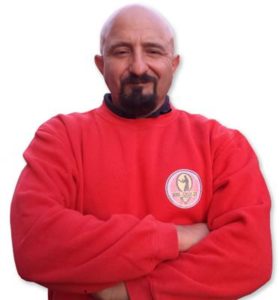Ever wonder, “What is the deal with WingTchunDo (WTD)?” For this post, Scott decided to sit down and have a chat with founder of WTD, Sifu Fernandez. We learned about his fighting background, who he trained with, and what his version of Wing Chun stands for.
We felt it might also be good to give some of the newer readers a quick reference on the names, without going into details behind each one:
– Wing Chun: the generic name of the art of Wing Chun Kung Fu (There are many spellings). It refers to the art as a whole and encompasses all lineages and styles.
– Ving Tsun: a widely used spelling of the art of Wing Chun. It is used to differentiate some lineages from others. All Ving Tsun is from Ip Man students.
– WingTsun: A trademarked version of Wing Chun that represents Sifu Leung Ting’s system of the art. Leung Ting was an Ip Man student.
– WingTchunDo: Sifu Fernandez’s trademarked name to represent his evolution of the art.
– Others: Other spellings are also usually derivatives of Leung Ting’s WingTsun. For example, Sifu Sergio’s WingTjun. Thommy Luke Boehlig’s WingTsjun, Emin Boztepe’s WingTzun, etc. There are many others. This most occurs when the Sifu breaks away from the main Leung Ting lineage and starts their own trademarked version of the art.
So, now let’s see what Sifu Fernandez has to say about WingTchunDo!:
How did you get started in Wing Chun?
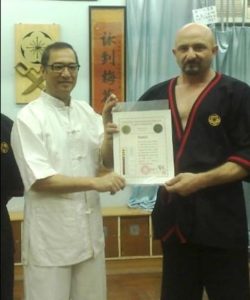 In Australia around 1972 I started Wing Chun in with the late Master Jim Fung. I was 7 years old, making me the youngest person to learn WC from the Yip Man-Tsui Shun Tin (Chu Shong Tin) lineage at that time. We were fortunate to have direct contact with Sifu Jim Fung and GM Tsui Shun Tin would travel from Hong Kong to do seminars.
In Australia around 1972 I started Wing Chun in with the late Master Jim Fung. I was 7 years old, making me the youngest person to learn WC from the Yip Man-Tsui Shun Tin (Chu Shong Tin) lineage at that time. We were fortunate to have direct contact with Sifu Jim Fung and GM Tsui Shun Tin would travel from Hong Kong to do seminars.
Who were your main training influences? Was there anyone you trained with in the past that really impacted your fighting style?
I had a lot of influences. Being young I looked up to Sifu Graham Kerschner who was one of the highest ranking instructors in Australia. As I grew up I looked at other people from other styles… one in particular was a good friend of mine Sensei Vince Palumbo. Who created his own style known as Arjukampu and he was a very fierce all around instructor… he had a lot of belief in himself and also inspired me to look deeper into what I was doing.
If you want to look at external inspirations, I would definitely rate Bruce Lee as my number one as a child. Of course I was heavily influenced by Muhammad Ali. By the 80s, I was heavily influenced by Sifu Boztepe’s mentality on fighting as well. I did many years of Boxing and eventually I integrated many of the boxing angles and distances to the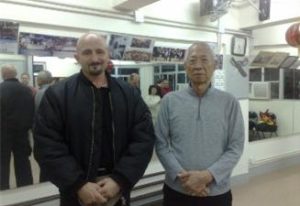 fighting applications I use in Wing Chun.
fighting applications I use in Wing Chun.
I’ve been told that in some of your training videos online, you recommend to WingTsun beginners to start out with the majority of their weight on their back leg of their stance. As they become more advanced, they should position themselves with a 50/50 stance (50% of their weight on the front leg and 50% of their weight on the back leg.) Why is that and how did you make this discovery or training choice?
Initially, I teach the methodology used in the Leung Ting lineage. My main changes were brought about because I realized from doing security work I needed to constantly be on the move. The idea of putting weight 100 percent on one leg was transitory. You don’t realize it but when you walk you put 100 percent of your weight on each foot as you move…. Not being conscious of it could limit your perspective…. If you are dealing with riots or more than one person, understanding footwork gives you a great advantage. That is why later on I teach something called 50/50 stance. As I said it is momentary and when you deal with pressure in Wing Chun or WingTsun you will find that as you move or lever out a person you are taking his weight and dispersing it on one foot at a time. Even when I am in a 50/50 position, it is just a natural position and when I confront pressure I change my footwork accordingly.
From what I understand, you also body build/lift weights. Is their any kind of weight exercises we should be training for our Wing Chun?
I don’t often lift heavy weights any more. I have trained methods which increase your power through form work that increase your muscular capacity a great deal. I do train abdominal muscles and I like using a heavy sledge hammer of about 20 kilos and I do a lot of spiral work. I train various exercises with the heavy Bart Chum Dao. I also train with very hard and heavy wall bags. Which I filled with sand and rubber followed by pouring water through it to making it almost rock hard. Then I work out with the wooden dummy. I embraced that very heavily with little flexibility because I believe that with my power I will eventually soften. I also do a lot of nunchuku and escrima work, as I believe it helps me generate power through and beyond my wrist and I can adapt this to my Wing Chun work. I do some Chi kung training, which helps me develop mental concentration, spinal strength and power.
Another workout worth mentioning is what is a special push up program which I call mini-flexes… I average about 350 although my record is 550 hits in one go. These are some of my main power training devices I use and I try to stick to non-agonistic exercises. I keep to a lot of the internal workings of Wing Chun… but that is a long story and I would need a book to explain why I choose this path… However, if one person does some research or finds a book on the late Australian, Jon Edmondson, he was a great inspiration for me to understand the difference on how to train which I adapt to my Wing Chun workouts. There are other exercises that I do, but it is too much information for me to explain in this interview.
In one of your YouTube videos you talk about active and passive training. How would you define the two trainings styles? What is the main concept behind this thought process?
http://www.youtube.com/watch?v=rFbZsMO_IJ8
Hmmm. Good question and you picked a video which I had forgotten I published on the net. Hahaha. Putting it simply, I believe very much in structure. It must have a capability or a way in which all students of all shapes and sizes can apply it…. I believe simply in the concept of maintaining my arm and body as a flexible arc, or bow and arrow effect…which generates energy back towards you. For example, if I press the branch of a tree it always maintains its structure and is able to generate a spring like pressure back towards whoever pushes it… Now imagine the trunk having 2 legs and moving forward. This is a very basic idea of what I mean of being passive and still maintaining forward pressure at the same time. The theory of Nim Lik, the power of thought, is very important to me and one of the influences in my life is from my good friend Sifu Tony Psailia. I basically grew up with him in Australia and he specializes in this type of work.
Once I understood this concept, I felt the sections were of less importance. Yes, I had influences from Tai Chi… I believe Wing Chun has similar ideas, but is essentially different because it is direct with its pressure and is very specific with its shot range application. Nevertheless, Tai Chi opened my mind and the work of circular energy. Although very little is included in my work and research. Fundamentally, if one looks at Chi Sao, long pole and some sections of the Bart Chum Dao you will find a lot of circular work applied… Personally I feel a lot of this type of work should be taught sooner rather than later. This is also because a lot of students suffer from shoulder problems and lower back problems if training incorrectly.
Recently you released A LOT of video (around 75 hours) in Wing Chun University. What makes it different than other training materials that are currently on the market today?
Actually, we are looking at over 75 hours and it is still growing… I take the time to verbally explain in great detail the inner workings of what we do… I felt it was important to show Wing Chun from a fighting perspective helping people understand the reality of what works.
I will stress that my research is based on the countless times I have had confrontations in 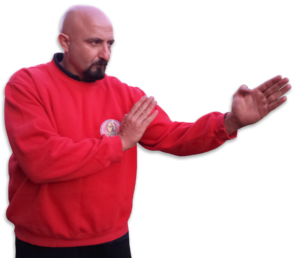 heavy duty security work and I have translated my interpretation to Wing Chun based from over 20 years experience in the field. When I was asked to create videos, I thought “why not create something in which a student is actually attending a seminar or having a private tutor in his home?” I wanted to create the feeling that you had me inside your home talking and teaching you personally…. I feel I have obtained this result.
heavy duty security work and I have translated my interpretation to Wing Chun based from over 20 years experience in the field. When I was asked to create videos, I thought “why not create something in which a student is actually attending a seminar or having a private tutor in his home?” I wanted to create the feeling that you had me inside your home talking and teaching you personally…. I feel I have obtained this result.
I also included the WingTchunDo system, which is an evolution program that enhances your Wing Chun skills in adapting to other fighting systems there will always be new videos coming out. You can be reassured that I have included the whole system with an integration of what I learned from the GGM Yip Man – GM Tsui shun Tin and GM Leung Ting family trees. You get the core system which is all the forms. All the Chi Sao sections, long pole, and Bart Chum Dao.
How long did it take you to film?
Whooaah way too long… I don’t know if I would ever do something like this again (laughing.) But nevertheless I started the project and kept my word to finished it. I think it took me something like 16 hours a day and many many months… I nearly lost my eyesight (joking) working on the computer…you see I had to do everything myself. From filming, organizing people… I had to rebuild a small studio which would be acceptable for presentation. I had to learn about filming and editing, which drove me crazy… I live in an area where there are constant power failures and black outs… I really thought at times I would not be able to finish it…
Plus I nearly lost my archives because I didn’t have time to do back ups and so I had a good friend who is a computer tech help me out…. I have to deeply thank Aaron Cantrell to see who was willing to Skype me and we would talk until about 3 in the morning helping me out or screen sharing to see what I was up to… Aaron is a top top guy…. Very honest and very helpful…rare thing to see these days.
But at the end I finished it and I’m still filming as we speak. I’m preparing new video files for further integration to the University. The University is unique…it will be academically certified and it will give people chance to complete their studies. It will give them a chance to be certified directly from me or one of my representatives in other parts of the world. It will give a chance for people to open schools as well with my certification and blessing… so these are very important attributes which I feel the public should know…
Another important thing is that they get the chance to save a lot of money as well and learn programs which normally in other parts of the world costs thousand and thousands of dollars.
From what I understand the pole and sword forms you teach are different than many other instructors. What makes them unique? Can we expect to learn different attributes that can be applied to our Kung Fu?
I guess everything is up for interpretation…my main influences of what I have learned 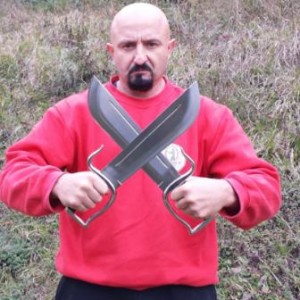 comes from the Leung Ting lineage…as many teachers do after many years of training, each puts a little of his own into it. I have never been a person who is fixed with his concepts. I try and keep any growth and personal interpretation always faithful to where the source comes from. Predominantly I keep my loyalty to the Yip Man lineage…
comes from the Leung Ting lineage…as many teachers do after many years of training, each puts a little of his own into it. I have never been a person who is fixed with his concepts. I try and keep any growth and personal interpretation always faithful to where the source comes from. Predominantly I keep my loyalty to the Yip Man lineage…
The long pole and sword work gives me a perspective to a reality that reigned hundreds of years ago. The fact that these weapons were used to fatally harm a human being makes you think of things much more seriously. It makes me look at my empty hand applications in a much more serious manner. Therefore it helps me more with my combat application.
If you ask me what is unique, well that’s not easy to answer…. There is an old saying that states “nothing in combat is truly unique…that all you have thought has already been invented or thought of in the last thousands of years of mans evolution…”
What is truly unique that we never had before is the fact we can document and record and archive everything we do… One hopes that a lot of this information will be preserved and kept for future generations… This will definitely help with growth and evolution.
What is global Chi Sao and why should we be training it? Is it similar to Tai Chi push hands, or is it more like the Chi Sao we find in mainland China? I was looking though your videos and it caught my interest.
Global Chi Sao has similarities to Tai Chi Pushing hands. Recently I took part in ceremonial combat with a renowned Tai Chi expert in France… he comes from the Chen Family and is also considered a fighter. He was very humble (a big guy) and we had tea together, we talked about our studies and then we moved onto having an exchange. This went on for about 50 minutes and we did a lot of body shifting, circular pushing hands (which included a lot of strikes,) of all sorts, elbows, palm strikes differing punches and so on. I was honored when at the end he proclaimed I had reached a state of ‘no style’ meaning I didn’t need to stick to any fixed patterns and what I did I did freely with no thought.
Global Chi Sao is a connecting point between Wing Chun and other styles… It is really an important factor because you study body mechanics in a very relaxed state. You also learn to recycle energy from any position, high or low and fundamentally it is a bridge to evolve your Wing Chun and adapt it to other fighting systems. Wing Chun Chi Sao has taught me this mechanism and I consider it an important evolution that has embraced the Yip Man Wing Chun principles.
What is the difference between JKD and WingTchunDo?
People often asks me the difference between Jeet Kune Do and WingTchunDo, possibly some people feel like I am trying to cash in Bruce Lee’s theory or that I am copying him. Copying him is not correct and certainly not true. I can say that I was inspired by him.
There is a huge difference in JKD and WTD. I have studied other martial arts, but WTD is integration, a gap filler, a metaphoric bridge that connects Wing Chun with other types of martial arts. It is important to point out that my loyalty is fiercely connected to the theory of Wing Chun. It is through the study of Chi Sao and body mechanics that I am able to look at all styles and integrate them with the theory of Wing Chun. Sound crazy?….. But it’s true.
If one studies Chi Sao completely and looks at the mechanics of recycling energy…well really if you think about it…any style can do it…maybe they don’t know how because they haven’t had a Chi Sao structure to help them…but if you look at a global approach to Chi Sao it really teaches us to take form of any angle and any pressure. Does it not?
“It is important to point out that my loyalty is fiercely connected to the theory of Wing Chun.”
Isn’t Chi Sao meant to be the pure essence of Wing Chun? Wing Chun is like an eternal spring; it is always blossoming and evolving. If we look at the aspects of Taoism, we know nothing can stay the same. If we look at the words of the great Bruce Lee..he once said, “if I fill the cup with water the water BECOMES THE CUP.”
Well, if this theory is true, than global Chi Sao helps you to make this into a reality. Global Chi Sao will help study the mechanics of all systems. When you realize that we all have a spine, two legs, two arms and muscular functions are almost identical then you start to realize that many systems start to look very similar.
This is the essence of WingTchunDo… I aim to bring people through hard training to truly become free and independent with a system that belongs to their personality.
Do you have any final thoughts?
I do not proclaim myself to be the holder of any ultimate ‘true’ Wing Chun… I really don’t like this mentality… I personally don’t believe in an ultimate Wing Chun… there are people out there who studies Wing Chun history like Sifu Benny Meng or Sifu Ladarola and they are always coming out with new findings which they share with the world…
Wing Chun can change your perspective. Personally I feel like I am always growing daily, I never stop learning. Although I have taught you the core system I do not want future students to feel oppressed because I come out with new videos… you have a very good base system, which I feel is pretty advanced, but you also get new programs that are meant to help you evolve and will not conflict with your academic gratings…I am a teacher who has done his best to work hard and make the Wing Chun I teach as practical as possible… Always respect other lineages. Also, I always keep my mind open to learn new or different realities in particular in the Wing Chun world.
Thank you for interviewing with us Sifu Fernandez! We look forward to checking out your new course in Wing Chun University! (You can launch Sifu Fernandez’s WCU course catalog here)

